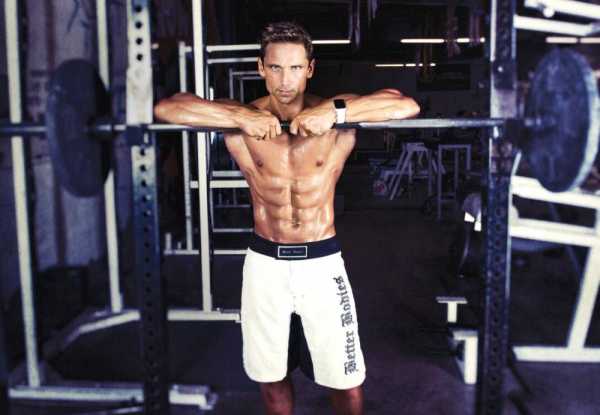Arsenal have won their last five games, scoring 21 goals; Martin Odegaard has been key to their attacking improvement; follow Porto vs Arsenal in the Champions League last 16 on Sky Sports’ digital platforms from 6.30pm on Wednesday; kick-off 8pm
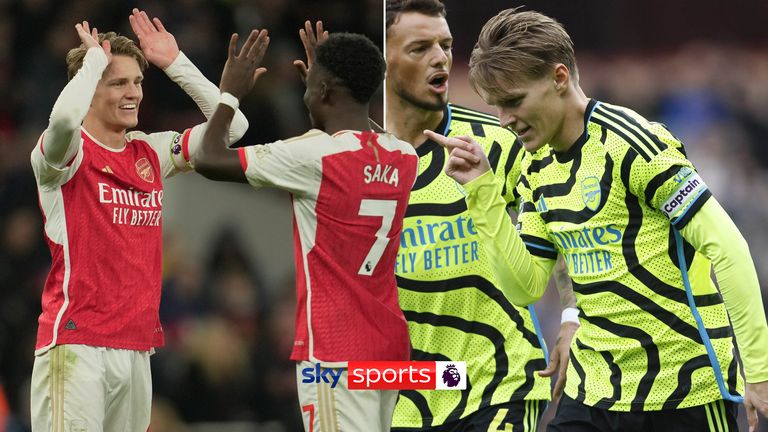
Watch Arsenal captain Martin Odegaard’s best moments in the Premier League this season
Martin Odegaard scored the first goal and set up the third in Arsenal’s 5-0 thrashing of Burnley on Saturday. He was similarly productive in the 6-0 win over West Ham, providing two assists.
The goal involvements came after a run of five games without one for the Arsenal captain. But his importance to their attacking improvement goes back further than the last few games.
In fact, it can be traced to the end of November, when Mikel Arteta decided to push Odegaard deeper, asking him to serve as a bridge between defence and midfield as well as midfield and attack.
The impact of the change was not immediately obvious. Arsenal soon embarked on a run of one win in five. But even as they were struggling for cutting edge, their chance creation was on the up.
- Arsenal news and rumours: Thomas Partey returns to training
- Outscoring Cristiano Ronaldo? Bukayo Saka’s amazing numbers

Image: Arsenal's first 13 Premier League games compared to their most recent 12
The numbers are compelling. In the first 13 games of the season, before Odegaard’s change of role, Arsenal ranked sixth for goals scored, seventh for expected goals, and even lower, in ninth, for non-penalty expected goals, underlining their issues from open play.
In the 12 games since, however, their output has been transformed. Arsenal rank top for goals scored. Only Liverpool have generated more expected goals. Most significantly, though, they have climbed from ninth to first in terms of non-penalty expected goals.
Those numbers have of course been boosted by their current five-game winning run, during which they have found the net 21 times. But Arsenal have been creating the opportunities consistently.
In the 2-0 loss to West Ham after Christmas, for example, they actually created better chances than in Saturday’s five-goal win at Burnley, totalling 2.77 expected goals compared to 2.36 at Turf Moor.
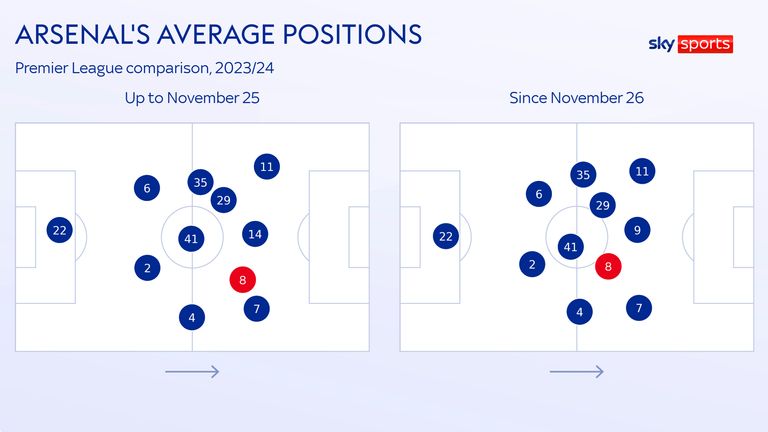
Image: Odegaard (8) has been playing deeper since the end of November
Finally, they have found some cutting edge to match. Bukayo Saka, Gabriel Martinelli and Leandro Trossard have hit 13 goals between them in the last month. But Odegaard has been the facilitator.
The 25-year-old had an awkward start to the campaign, struggling to exert his usual influence from the position in which he shone last term and even finding himself dropped for the win over Sheffield United in October. But it all changed when he moved further back.
Odegaard’s numbers for touches and passes have risen dramatically. There is more focus on dropping into his own half to build the play. But it has not come at the cost of creativity. In fact, he is making more chances than ever, averaging four per game.

This is not the first time Arteta has adapted Odegaard’s positioning. In an interview with Sky Sports in 2022, the Arsenal boss detailed his efforts to push him in the other direction.
“I think now he is more comfortable doing that [playing further forward] than when he joined because he was all the time playing in deeper roles and getting the ball in deeper areas,” said Arteta.
“He was more comfortable facing the play from those positions than being in advanced positions. But that is the work we have been doing with him. In my opinion, that is where he can be the best for the team.”
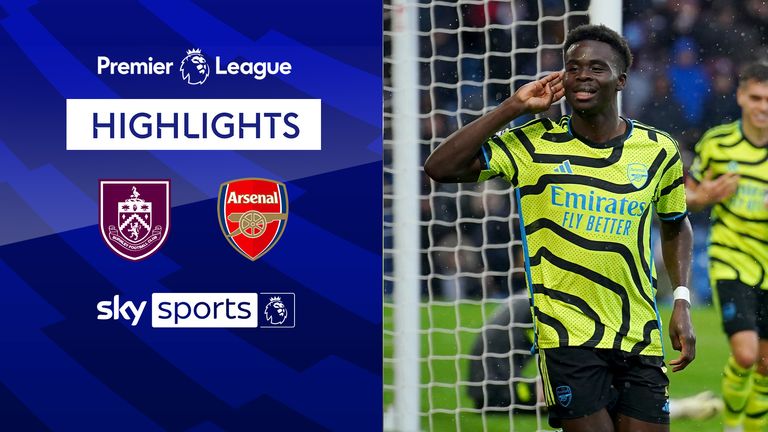
Watch free highlights of Arsenal’s 5-0 win over Burnley
Arteta was vindicated. Odegaard’s total of 15 goals last season was the most by an Arsenal midfielder since Cesc Fabregas in 2009/10. But the dynamics of the side changed with Kai Havertz’s arrival in place of Granit Xhaka. Soon, opponents were sitting deeper.
Odegaard had to change too. “We have used Martin to accommodate the needs of the team, to make us better against certain behaviours and challenges that the opponents put for us,” explained Arteta in December. “That is a big quality of his.”

Image: Odegaard is making considerably more passes in deeper areas
It is a testament to Odegaard’s tactical intelligence that he has adapted so smoothly. Now, he is now starting moves as well as finishing them.
His passing zones show his heightened presence in his own half and there is further evidence of his increased role in Arsenal’s build-up play when breaking down who he is receiving passes from.
Since late November, he is collecting more than three times as many passes from right-sided centre-back William Saliba as he was previously. His passes received from Declan Rice have doubled too.
Datawrapper This content is provided by Datawrapper, which may be using cookies and other technologies. To show you this content, we need your permission to use cookies. You can use the buttons below to amend your preferences to enable Datawrapper cookies or to allow those cookies just once. You can change your settings at any time via the Privacy Options. Unfortunately we have been unable to verify if you have consented to Datawrapper cookies. To view this content you can use the button below to allow Datawrapper cookies for this session only. Enable Cookies Allow Cookies Once
Arsenal, too often slow and predictable in their build-up play in the early months of the season, now look slick and incisive. “The connection of the players is flowing,” said Arteta when asked to explain their prolific form after the win over Burnley.
That flow has a lot to do with Odegaard. A player previously responsible for providing the final flourishes in the attacking third is now plotting the ball’s journey from one end to the other.
Datawrapper This content is provided by Datawrapper, which may be using cookies and other technologies. To show you this content, we need your permission to use cookies. You can use the buttons below to amend your preferences to enable Datawrapper cookies or to allow those cookies just once. You can change your settings at any time via the Privacy Options. Unfortunately we have been unable to verify if you have consented to Datawrapper cookies. To view this content you can use the button below to allow Datawrapper cookies for this session only. Enable Cookies Allow Cookies Once
In terms of passes made, the biggest difference is in how frequently he is now combining with Rice. But most significant is that his change of role has allowed him to increase his service to Saka, scorer of six goals in the last four games.
Saka is not the only forward to have benefitted. Odegaard is finding Trossard nearly twice as often as he was. The Belgian, like his younger team-mate, is getting more chances and scoring more goals.
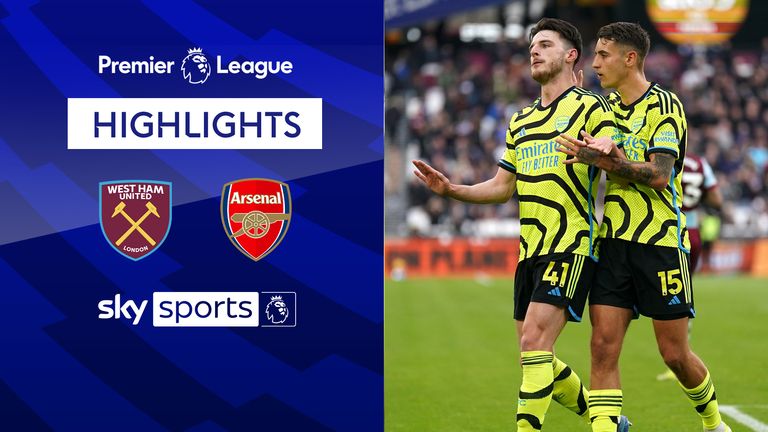
Watch free highlights of Arsenal’s 6-0 thrashing of West Ham
Odegaard’s passes to Havertz have only increased modestly by comparison. But the German seems better off for the change too, with Odegaard’s deeper positioning freeing him up to get forward on the opposite side of Arsenal’s midfield.
Odegaard’s cute pass to release Saka for the third goal against Burnley was his sixth assist of the season. But that number alone does not show the full extent of his creative contribution.
Indeed, even taking into account that awkward start to the season which culminated in him being dropped, Odegaard ranks top among Premier League players for passes leading to a shot this season, his total of 98 putting him 13 clear of anyone else.
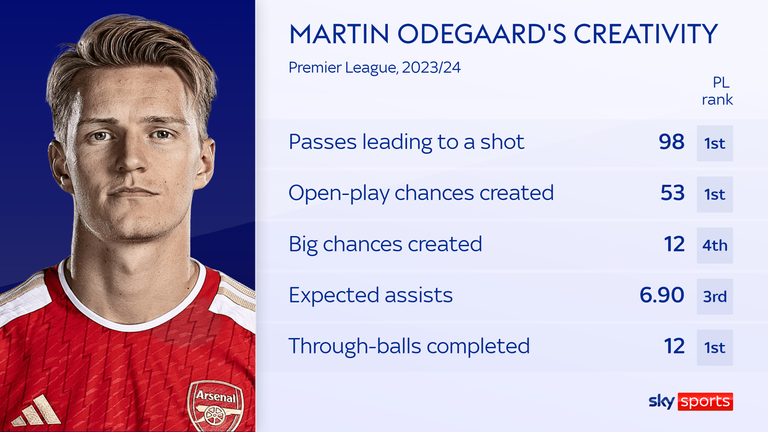
He sits in the same spot for open-play chances created and successful through-balls. He also ranks among the Premier League’s top four players for big chances created and expected assists.
It is quite a feat given he is adapting to a new position which takes him further away from goal. But Odegaard has adapted again, dropping back to push the team forward.
Recent evidence shows Arsenal are feeling the benefits.
Get Sky Sports on WhatsApp

You can now receive messages and alerts for the latest breaking sports news, analysis, in-depth features and videos from our dedicated WhatsApp channel. Find out more here…
Sourse: skysports.com
